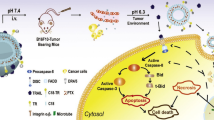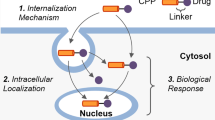Abstract
The efficacy of nanoparticle drugs necessitates the high bioactivity of constituents, but the distribution of the nanoparticles in organisms is mostly determined by their physical properties. Therefore, generation of stable particles with strictly defined characteristics is highly essential. Here we describe a formulation protocol of stable and homogenous CPP/pDNA nanoparticles for in vivo applications.
Access this chapter
Tax calculation will be finalised at checkout
Purchases are for personal use only
Similar content being viewed by others
References
Kurrikoff K, Gestin M, Langel Ü (2016) Recent in vivo advances in cell-penetrating peptide-assisted drug delivery. Expert Opin Drug Deliv 13:373–387
Veiman K-L et al (2015) PEG shielded MMP sensitive CPPs for efcient and tumor specifc gene delivery in vivo. J Control Release 209:238–247
Künnapuu K, Veiman K-L, Porosk L, Rammul E, Kiisholts K, Langel Ü et al (2018) Tumor gene therapy by systemic delivery of plasmid DNA with cell-penetrating peptides. FASEB Bioadv 1(2):105–114
Freimann K, Arukuusk P, Kurrikoff K, Vasconcelos LDF, Veiman K-L, Uusna J et al (2016) Optimization of in vivo DNA delivery with NickFect peptide vectors. J Control Release 241:135–143
Kurrikoff K, Veiman K-L, Künnapuu K, Peets EM, Lehto T, Pärnaste L et al (2017) Efective in vivo gene delivery with reduced toxicity, achieved by charge and fatty acid -modifed cell penetrating peptide. Sci Rep 7:17056
Freimann K, Arukuusk P, Kurrikoff K, Pärnaste L, Raid R, Piirsoo A et al (2018) Formulation of stable and homogeneous cell-penetrating peptide NF55 nanoparticles for efficient gene delivery in vivo. Mol Ther Nucleic Acids 10:28–35
Acknowledgments
The authors are supported by the EU project 2014-2020.4.01.15-0013, but this did not bias the current work in any way.
Author information
Authors and Affiliations
Corresponding author
Editor information
Editors and Affiliations
Rights and permissions
Copyright information
© 2022 The Author(s), under exclusive license to Springer Science+Business Media, LLC, part of Springer Nature
About this protocol
Cite this protocol
Arukuusk, P., Härk, H.H., Langel, Ü. (2022). Utilization of Cell-Penetrating Peptides for In Vivo Delivery of Bioactive Cargo: The Effect of Nanoparticle Formulation. In: Langel, Ü. (eds) Cell Penetrating Peptides. Methods in Molecular Biology, vol 2383. Humana, New York, NY. https://doi.org/10.1007/978-1-0716-1752-6_16
Download citation
DOI: https://doi.org/10.1007/978-1-0716-1752-6_16
Published:
Publisher Name: Humana, New York, NY
Print ISBN: 978-1-0716-1751-9
Online ISBN: 978-1-0716-1752-6
eBook Packages: Springer Protocols




